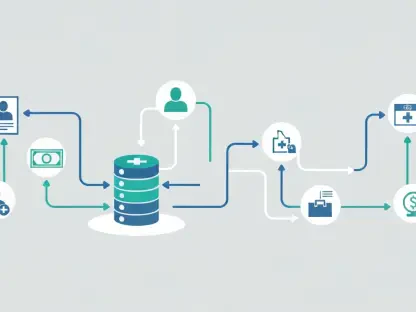In today’s digital landscape, APIs (Application Programming Interfaces) are undeniably pivotal. They enable the seamless integration and communication between diverse software components and systems, forming the backbone of modern tech infrastructure. However, as their adoption expands, so do the associated security risks, particularly with the advent of AI-powered threats. As APIs continue to permeate various facets of technological ecosystems, understanding and tackling the intricate security challenges they pose becomes paramount for organizations striving to safeguard their digital assets effectively.
Rising Threats and AI’s Double-Edged Sword
The Dual Role of AI
APIs are integral to the success of AI and large language models (LLMs), driving innovation and creating new opportunities. Conversely, these advancements also arm cybercriminals with cutting-edge tools to enhance their attack strategies, thus posing significant security threats to APIs. The dual role of AI in both enabling progress and facilitating attacks underscores a delicate balance that organizations must navigate. While AI-powered solutions can streamline processes and improve efficiency, they also require sophisticated security measures to prevent exploitation.
AI technologies have evolved rapidly, and their application in cybersecurity has taken various forms, ranging from automated detection systems to predictive analytics. However, the same technologies can be repurposed by malicious actors to craft more sophisticated and elusive attack vectors. This paradox places added pressure on the security frameworks governing APIs, necessitating continuous adaptation and advancement of defensive strategies to keep pace with evolving threats. As AI-driven innovations unfold, the potential for remarkably potent attacks grows, demanding vigilant and proactive security postures.
AI-Enhanced Attacks
AI’s incorporation into cyber threats has made such attacks the preeminent concern for IT leaders. A substantial percentage of these executives, 74%, express extreme concern about AI’s role in API security threats, with 32% deeming AI-powered attacks to be the most substantial risk currently. This heightened vigilance stems from the transformative ability of AI to bypass conventional defense mechanisms, exploit vulnerabilities more effectively, and carry out attacks at an unprecedented scale.
AI-enhanced attacks often manifest as sophisticated intrusions that are difficult to detect and mitigate using traditional security tools. These attacks leverage AI to identify weak links, automate exploitation, and obfuscate malicious activities, making them exceptionally challenging to counteract. For instance, AI can be utilized to analyze massive data sets, pinpointing vulnerabilities and devising optimized strategies for infiltration without human intervention. Moreover, adversaries employing AI can swiftly adapt their attack methodologies based on real-time feedback, thereby continuously evolving their threat approaches.
Unseen and Unmanaged APIs
The Danger of Shadow APIs
Shadow APIs, those unmanaged and often unknown to IT teams, create severe security vulnerabilities. These neglected endpoints operate outside the surveillance of security measures, leading to substantial security gaps within organizations. The presence of such APIs is frequently a byproduct of rapid development cycles, where expedient implementations overshadow meticulous governance. Consequently, these APIs may remain undocumented and excluded from regular security audits, rendering them susceptible to unauthorized access and exploitation.
Without a comprehensive inventory and monitoring system, shadow APIs can proliferate unnoticed, posing silent threats to organizational security. Attackers can leverage these hidden endpoints to gain entry into protected systems, exfiltrate sensitive data, or disrupt operations. The challenge of managing shadow APIs is exacerbated by their dynamic nature; they can emerge spontaneously as developers experiment with new functionalities or integrate third-party services, complicating the task of maintaining a robust security perimeter.
Gartner’s Insights on Dormant APIs
Gartner’s 2024 Market Guide for API Protection underscores risks related to shadow and dormant APIs. The scale and impact of breaches involving these APIs are significant, exacerbating the API security challenge as infrastructures typically contain countless vulnerable endpoints. Dormant APIs represent a particularly insidious threat as they lie inactive yet still accessible, often with outdated or inadequate security measures. Such APIs can be instruments for attackers who seek low-hanging fruits within sprawling infrastructures.
Organizations must heed Gartner’s warnings by prioritizing a thorough audit of all API endpoints, including those that are supposedly dormant. This involves not only cataloging active APIs but also instituting policies that regularly review and secure dormant APIs. Failure to do so can open gateways for nefarious activities where overlooked endpoints become conduits for data breaches. The comprehensive management of API security requires a systemic approach, integrating both proactive discovery and reactive mitigation strategies to cover the full spectrum of potential vulnerabilities.
Organizational Preparedness
Overconfidence in Security
A worrying disconnect exists between the perceived readiness of IT leaders and actual preparedness. Despite 85% of these leaders expressing confidence in their API security, 40% remain uncertain about the adequacy of their security investments, with an alarming number dedicating substantial portions of their budget specifically to API security. This disparity indicates a potential overestimation of current protective measures and highlights the necessity for reassessment and reinforcement.
The confidence reported by IT leaders may stem from deploying state-of-the-art security solutions without continually validating their effectiveness against evolving threats. Overconfidence can lead to complacency, where critical vulnerabilities persist due to assumptions that existing measures suffice. To bridge this gap, regular stress testing, red teaming, and third-party security audits should be integral to organizational security practices, ensuring that perceived security aligns with actual capabilities and resilience.
Real-World Incidents and Misalignment
APIContext’s CEO has emphasized that 25% of organizations have faced AI-enhanced threats. Despite the high self-reported confidence levels, a concerning number continue to experience security incidents, revealing a gap between perceived and actual security strength. This misalignment suggests that while protective measures may be in place, they are either inadequate or improperly implemented against sophisticated, AI-driven threats.
The disparity between confidence and real-world incidents could be attributed to several factors, including the dynamic nature of cyber threats, insufficient training, or a lack of continuous improvement in security protocols. Organizations must not only invest in advanced security technologies but also cultivate a culture of vigilance and adaptability. This involves training personnel to recognize and respond to emerging threats, embedding security into the core development process, and fostering a mindset where proactive security management is paramount.
Strategies and Technological Solutions
Standard Measures and Zero-Trust Architectures
Organizations are tackling API security threats with various approaches, such as API monitoring, anomaly detection, and API gateways. Surprisingly, only a fraction have employed zero-trust architectures, a best-practice strategy for robust security. Zero-trust models operate on the principle of “never trust, always verify,” ensuring that every access request is authenticated and authorized, irrespective of its source or destination.
The limited adoption of zero-trust architectures can be attributed to the complexity and resource intensity associated with their implementation. Nevertheless, integrating zero-trust principles can significantly bolster API security by minimizing the attack surface and enforcing strict access controls. Organizations that have embraced zero-trust frameworks report enhanced resilience against intrusions, as these architectures inherently mitigate risks by assuming that breaches are inevitable and preparing defenses accordingly.
Proactive Countermeasures
While a large majority of organizations are implementing steps to counter AI-driven attacks, discrepancies exist, particularly across regions. For instance, 13% of U.S. organizations admit to taking no specific measures against AI threats, compared to just 4% in the UK, highlighting differences in approach to security. Such regional variations underscore the necessity for standardized, globally-recognized security protocols that ensure consistent defense measures irrespective of geographic exigencies.
Proactive countermeasures involve a multifaceted approach, encompassing continuous monitoring, threat intelligence sharing, and regular security training. Organizations must stay ahead of adversaries by employing adaptive security strategies that can evolve in real-time based on emerging threat landscapes. Incorporating AI-driven defense mechanisms to counter AI-enhanced attacks creates a dynamic security posture, enabling automated detection and mitigation of sophisticated threats. This strategy requires a commitment to ongoing investment in cutting-edge technologies and fostering cross-regional collaborations for comprehensive threat mitigation.
The Path Forward
Future Challenges with AI
With AI and LLM technologies evolving rapidly, the complexity of managing API security is anticipated to escalate. Many IT leaders predict increased security challenges due to these advancements in the near term. As AI-driven innovations continue to unfold, the potential for remarkably potent attacks grows, demanding vigilant and proactive security postures. Organizations must adapt their strategies to address both current threats and foresee future challenges brought about by the ever-changing landscape.
The expected escalation in security complexity necessitates an agile and resilient approach to cybersecurity. This means not only adopting advanced defensive technologies but also cultivating a forward-looking mindset that anticipates and prepares for future threats. Organizational preparedness will hinge on the ability to swiftly adapt to new developments in AI, continually enhancing security measures to keep pace with evolving methodologies.
Developing Proactive Strategies
In today’s digital world, APIs (Application Programming Interfaces) have become crucial. They allow for the smooth integration and communication between different software components and systems, serving as the backbone of modern technology infrastructure. However, as the use of APIs expands, so do the associated security risks, especially with the rise of AI-powered threats. APIs have become more widespread across various technological ecosystems. Consequently, it has become vital for organizations to understand and address the complex security challenges they present in order to effectively protect their digital assets. The evolving landscape of API utilization demands a proactive approach to security, incorporating advanced measures to counteract potential vulnerabilities and safeguard sensitive information. By prioritizing API security, organizations can better defend against emerging threats and ensure the integrity and reliability of their technological systems.









